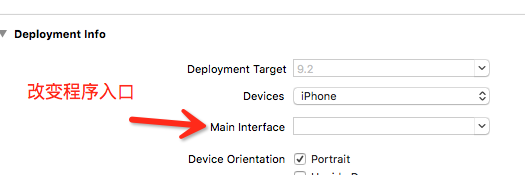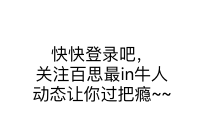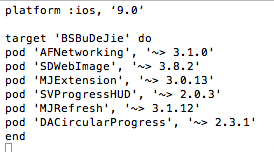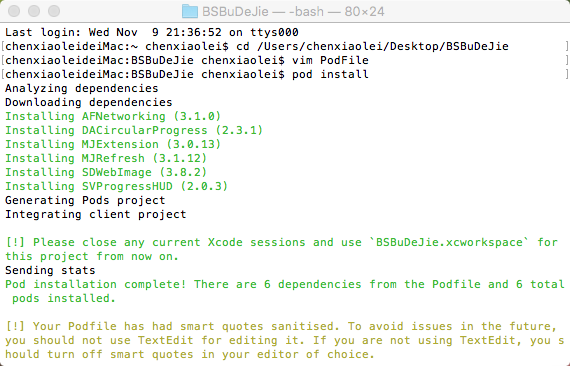一. 基本配置
1 项目图标
将图片直接拖入Assets-AppIcon
2 启动图片



3 软件名称

4 删除Main.stroryboard

5 设置窗口的根控制器
- (BOOL)application:(UIApplication *)application didFinishLaunchingWithOptions:(NSDictionary *)launchOptions { //创建一个窗口 self.window = [[UIWindow alloc] init]; self.window.frame = [UIScreen mainScreen].bounds; //设置窗口的根控制器 self.window.rootViewController = [[ViewController alloc] init]; //显示窗口 [self.window makeKeyAndVisible]; return YES; }
二 配置TabBar切换控制器
先把项目的骨架搭起来,即底部的TabBar控制器
1 基本UITabBarController设置(将tabBar的基本设置封装到自己的tabBar中)
UITabBarController *tabBarController = [[UITabBarController alloc] init]; UIViewController *vc1 = [[UIViewController alloc] init]; vc1.view.backgroundColor = [UIColor redColor]; vc1.tabBarItem.title = @"精华"; vc1.tabBarItem.image = [UIImage imageNamed:@"tabBar_essence_icon"]; vc1.tabBarItem.selectedImage = [UIImage imageNamed:@"tabBar_essence_click_icon"]; [tabBarController addChildViewController:vc1]; UIViewController *vc2 = [[UIViewController alloc] init]; vc2.view.backgroundColor = [UIColor grayColor]; vc2.tabBarItem.title = @"新帖"; vc2.tabBarItem.image = [UIImage imageNamed:@"tabBar_new_icon"]; vc2.tabBarItem.selectedImage = [UIImage imageNamed:@"tabBar_new_click_icon"]; [tabBarController addChildViewController:vc2]; UIViewController *vc3 = [[UIViewController alloc] init]; vc3.view.backgroundColor = [UIColor blueColor]; vc3.tabBarItem.title = @"关注"; vc3.tabBarItem.image = [UIImage imageNamed:@"tabBar_friendTrends_icon"]; vc3.tabBarItem.selectedImage = [UIImage imageNamed:@"tabBar_friendTrends_click_icon"]; [tabBarController addChildViewController:vc3]; UIViewController *vc4 = [[UIViewController alloc] init]; vc4.view.backgroundColor = [UIColor purpleColor]; vc4.tabBarItem.title = @"我"; vc4.tabBarItem.image = [UIImage imageNamed:@"tabBar_me_icon"]; vc4.tabBarItem.selectedImage = [UIImage imageNamed:@"tabBar_me_click_icon"]; [tabBarController addChildViewController:vc4]; //设置窗口的根控制器 self.window.rootViewController = tabBarController;

2 选中图片会默认做一个自动渲染
UIImage *image = [UIImage imageNamed:@"tabBar_essence_click_icon"]; //设置图片不会被渲染 image = [image imageWithRenderingMode:UIImageRenderingModeAlwaysOriginal];

3 设置字体
NSMutableDictionary *attrs = [NSMutableDictionary dictionary]; attrs[NSFontAttributeName] = [UIFont systemFontOfSize:16]; attrs[NSForegroundColorAttributeName] = [UIColor lightGrayColor]; [vc1.tabBarItem setTitleTextAttributes:attrs forState:UIControlStateNormal]; NSMutableDictionary *selectedAttrs = [NSMutableDictionary dictionary]; selectedAttrs[NSFontAttributeName] = [UIFont systemFontOfSize:16]; selectedAttrs[NSForegroundColorAttributeName] = [UIColor darkGrayColor]; [vc1.tabBarItem setTitleTextAttributes:selectedAttrs forState:UIControlStateSelected];


三 appearance的使用
通过appearance统一设置所有UITabBarItem的属性,后面带有UI_APPEARANCE_SELECTOR的方法,都可以通过appearance对象来统一设置
NSMutableDictionary *attrs = [NSMutableDictionary dictionary]; attrs[NSFontAttributeName] = [UIFont systemFontOfSize:16]; attrs[NSForegroundColorAttributeName] = [UIColor lightGrayColor]; NSMutableDictionary *selectedAttrs = [NSMutableDictionary dictionary]; selectedAttrs[NSFontAttributeName] = [UIFont systemFontOfSize:16]; selectedAttrs[NSForegroundColorAttributeName] = [UIColor darkGrayColor]; UITabBarItem *item = [UITabBarItem appearance]; [item setTitleTextAttributes:attrs forState:UIControlStateNormal]; [item setTitleTextAttributes:selectedAttrs forState:UIControlStateSelected];
四 自定义子控制器
将需要修改的属性作为变量,将代码的相同部分提取出来,可提高代码的可读性
在修改某些模块的时候,只需要在相应的子控制器中设置即可
/** * 初始化子控制器 */ - (void)setupChildVC:(UIViewController *)vc title:(NSString *)title image:(NSString *)image selectedImage:(NSString *)selectedImage { //设置文字和图片 vc.view.backgroundColor = [UIColor colorWithRed:arc4random_uniform(100)/100.0 green:arc4random_uniform(100)/100.0 blue:arc4random_uniform(100)/100.0 alpha:1]; vc.tabBarItem.title = title; vc.tabBarItem.image = [UIImage imageNamed:image]; vc.tabBarItem.selectedImage = [UIImage imageNamed:selectedImage]; //添加子控制器 [self addChildViewController:vc]; }
[self setupChildVC:[[UIViewController alloc] init] title:@"精华" image:@"tabBar_essence_icon" selectedImage:@"tabBar_essence_click_icon"];
五 自定义tabbar
1 直接在tabbar中添加项
UIButton *publishButton = [UIButton buttonWithType:UIButtonTypeCustom]; [publishButton setBackgroundImage:[UIImage imageNamed:@"tabBar_publish_icon"] forState:UIControlStateNormal]; [publishButton setBackgroundImage:[UIImage imageNamed:@"tabBar_publish_click_icon"] forState:UIControlStateHighlighted]; publishButton.frame = CGRectMake(0, 0, publishButton.currentBackgroundImage.size.width, publishButton.currentBackgroundImage.size.height); publishButton.center = CGPointMake(self.tabBar.frame.size.width / 2, self.tabBar.frame.size.height / 2); [self.tabBar addSubview:publishButton];
2 拿到tabbar的子控件
for (UIView * button in self.tabBar.subviews){ button.frame = CGRectMake(0, 0, 20, 20); }

3 当控制器的view布局完之后再布局一次
- (void)viewDidLayoutSubviews{ for (UIView * button in self.tabBar.subviews){ button.frame = CGRectMake(0, 0, 20, 20); } }

4 当把子控件拿出来也无法改变属性时,需要自定义tabbar
tabbar是只读属性,可以通过KVC,可以直接访问成员变量,自动赋值
//更换tabbar [self setValue:[[BSTabBar alloc] init] forKey:@"tabBar"];
已替换成功:

5 重新布局子控件 - (void)layoutSubviews{
[super layoutSubviews]; //设置发布按钮的frame self.publishButton.frame = CGRectMake(0, 0, self.publishButton.currentBackgroundImage.size.width, self.publishButton.currentBackgroundImage.size.height); self.publishButton.center = CGPointMake(self.frame.size.width / 2, self.frame.size.height / 2); //设置其他UITabBarButton的frame CGFloat buttonY = 0; CGFloat buttonW = self.frame.size.width / 5; CGFloat buttonH = self.frame.size.height; NSInteger index = 0;
for (UIView * button in self.subviews) { if (![button isKindOfClass:NSClassFromString(@"UITabBarButton")]) continue; CGFloat buttonX = buttonW * ((index > 1) ? (index + 1) : index); button.frame = CGRectMake(buttonX, buttonY, buttonW, buttonH); index ++; } }

六 封装frame的修改
1 使用分类
在分类中声明@propery,只会生成方法的声明,不会生成方法的实现和带有_的成员变量
@interface UIView (BSExtension) @property (nonatomic, assign) CGFloat width; @property (nonatomic, assign) CGFloat height; @property (nonatomic, assign) CGFloat x; @property (nonatomic, assign) CGFloat y; @end
@implementation UIView (BSExtension) - (void)setWidth:(CGFloat)width{ CGRect frame = self.frame; frame.size.width = width; self.frame = frame; } - (void)setHeight:(CGFloat)height{ CGRect frame = self.frame; frame.size.height = height; self.frame = frame; } - (void)setX:(CGFloat)x{ CGRect frame = self.frame; frame.origin.x = x; self.frame = frame; } - (void)setY:(CGFloat)y{ CGRect frame = self.frame; frame.origin.y = y; self.frame = frame; } - (CGFloat)width { return self.frame.size.width; } - (CGFloat)height { return self.frame.size.height; } - (CGFloat)x { return self.frame.origin.x; } - (CGFloat)y { return self.frame.origin.y; } @end
2 使用pch文件

七 设置导航栏
1 包装一个导航栏控制器,添加导航栏控制器为tabbarcontroller的子控制器
UINavigationController *nav = [[UINavigationController alloc] initWithRootViewController:vc];
[self addChildViewController:nav];
2 设置导航栏内容
//设置导航栏内容 self.navigationItem.titleView = [[UIImageView alloc] initWithImage:[UIImage imageNamed:@"MainTitle"]]; UIButton *tagButton = [UIButton buttonWithType:UIButtonTypeCustom]; [tagButton setBackgroundImage:[UIImage imageNamed:@"MainTagSubIcon"] forState:UIControlStateNormal]; [tagButton setBackgroundImage:[UIImage imageNamed:@"MainTagSubIconClick"] forState:UIControlStateHighlighted]; tagButton.size = tagButton.currentBackgroundImage.size; self.navigationItem.leftBarButtonItem = [[UIBarButtonItem alloc] initWithCustomView:tagButton];

3 使用自定义的NSLog,在调试的时候自动隐藏
#ifdef DEBUG #define BSLog(...) NSLog(__VA_ARGS__) #else #define BSLog(...) #endif
4 打印当前调用的函数
#define BSLogFun BSLog(@"%s",__func__)
八 封装UIBarButtonItem
1 使用扩展类给UIBarButtonItem添加一个方法
@interface UIBarButtonItem (BSExtension) + (instancetype)itemWithImage:(NSString *)image highImage:(NSString *)highImage target:(id)target action:(SEL)action; @end
@implementation UIBarButtonItem (BSExtension) + (instancetype)itemWithImage:(NSString *)image highImage:(NSString *)highImage target:(id)target action:(SEL)action{ UIButton *button = [UIButton buttonWithType:UIButtonTypeCustom]; [button setBackgroundImage:[UIImage imageNamed:image] forState:UIControlStateNormal]; [button setBackgroundImage:[UIImage imageNamed:highImage] forState:UIControlStateHighlighted]; button.size = button.currentBackgroundImage.size; [button addTarget:target action:action forControlEvents:UIControlEventTouchUpInside]; return [[self alloc] initWithCustomView:button]; } @end
self.navigationItem.leftBarButtonItem = [UIBarButtonItem itemWithImage:@"MainTagSubIcon" highImage:@"MainTagSubIconClick" target:self action:@selector(tagClick)];
九 调整项目文件结构
设置全局背景色
#define BSRGBColor(r, g, b) [UIColor colorWithRed:(r)/255.0 green:(g)/255.0 blue:(b)/255.0 alpha:1.0]; #define BSGlobalBg BSRGBColor(223, 223, 223)
十 自定义导航栏控制器
1 可以重写push方法来拦截所有push进来的控制器
/** * 可以在这个方法中拦截所有push进来的控制器 */ - (void)pushViewController:(UIViewController *)viewController animated:(BOOL)animated { [super pushViewController:viewController animated:animated]; viewController.navigationItem.backBarButtonItem = [[UIBarButtonItem alloc] initWithTitle:@"返回" style:UIBarButtonItemStyleDone target:nil action:nil]; NSLog(@"%@",viewController); }
2 改变导航栏的返回按钮的颜色(默认为黑, 点击为红)和位置
- (void)pushViewController:(UIViewController *)viewController animated:(BOOL)animated { if (self.childViewControllers.count > 0) {//如果push进来的不是第一个控制器 UIButton *button = [UIButton buttonWithType:UIButtonTypeCustom]; [button setTitle:@"返回" forState:UIControlStateNormal]; [button setTitleColor:[UIColor blackColor] forState:UIControlStateNormal]; [button setTitleColor:[UIColor redColor] forState:UIControlStateHighlighted]; [button setImage:[UIImage imageNamed:@"navigationButtonReturn"] forState:UIControlStateNormal]; [button setImage:[UIImage imageNamed:@"navigationButtonReturnClick"] forState:UIControlStateHighlighted]; button.size = CGSizeMake(70, 30); //让按钮内部的所有内容左对齐 button.contentHorizontalAlignment = UIControlContentHorizontalAlignmentLeft; //按钮的外边距 button.contentEdgeInsets = UIEdgeInsetsMake(0, -10, 0, 0); [button addTarget:self action:@selector(back) forControlEvents:UIControlEventTouchUpInside]; viewController.navigationItem.leftBarButtonItem = [[UIBarButtonItem alloc] initWithCustomView:button]; } //让viewController可以覆盖上面设置的leftBarButtonItem [super pushViewController:viewController animated:animated]; }
3 设置tabbar隐藏
//隐藏tabbar viewController.hidesBottomBarWhenPushed = YES;
十一 调整初始化代码
当第一次使用某个类时调用一次,在使用appearance时可以放入
/** * 当第一次使用这个类时调用一次 */ + (void)initialize { //当导航栏用在BSNavigationController中,appearence设置才会生效 UINavigationBar *bar = [UINavigationBar appearance]; [bar setBackgroundImage:[UIImage imageNamed:@"navigationbarBackgroundWhite"] forBarMetrics:UIBarMetricsDefault]; }
十二 颜色说明
1 24bit颜色: R G B
ff0000: 红色
00ff00: 绿色
0000ff: 蓝色
000000: 黑色
ffffff: 白色
灰色特点:RGB一样
2 32bit颜色: R G B A
ff0000ff
十三 关注模块
1 自动换行

2 label文字换行
alt+enter

十四 显示推荐关注
1 添加第三方框架
cd + 项目路径
vim PodFile

pod install

2 发送请求 <AFNetworking>
//发送请求 NSMutableDictionary *params = [NSMutableDictionary dictionary]; params[@"a"] = @"category"; params[@"c"] = @"subscribe"; [[AFHTTPSessionManager manager] GET:@"http://api.budejie.com/api/api_open.php" parameters:params progress:nil success:^(NSURLSessionDataTask * _Nonnull task, id _Nullable responseObject) { NSLog(@"%@",responseObject); } failure:^(NSURLSessionDataTask * _Nullable task, NSError * _Nonnull error) { }];
3 显示指示器 <SVProgressHUD>
/** 简单的等待提示 开始: [SVProgressHUD show]; 结束: [SVProgressHUD dismiss]; 提示内容: [SVProgressHUD showSuccessWithStatus:@"加载中..."]; */ /** 显示HUD以及指示任务的状态 + (void)show; + (void)showWithStatus:(NSString*)string; */ /** 在HUD指示任务的进度 + (void)showProgress:(CGFloat)progress; + (void)showProgress:(CGFloat)progress status:(NSString*)status; */ /** 隐藏HUD + (void)dismiss; + (void)dismissWithDelay:(NSTimeInterval)delay; */ /** 显示多个HUD 该HUD将自动消失,popActivity将与显示的次数匹配 + (void)popActivity; */